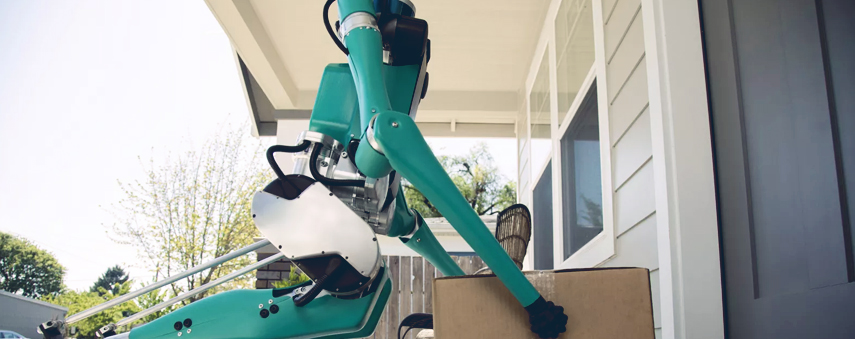Will Ford’s new delivery robot transform how we use autonomous vehicles?

Cars cannot deliver packages alone. Autonomous vehicles may seem perfect for online shopping but getting a parcel to a door requires human input. Or does it? This is the thinking behind Ford’s ambitious new robotic project.
Humanoid in design, Digit has a weird kind of adorability that the Boston Dynamics dog perhaps lacked. Digit is lightweight, not particularly quick or jerky in movement, and faceless. It’s usually the face after all that makes a robot look scary: often too, it’s a smiley look that looks the creepiest. But Digit’s design is hugely un-threatening. The sheer nature of a robot with a sole aim of being gentle with your Amazon parcel adds to this image; so whilst Digit may create human job redundancies, he’s too cute for you to hate him.
Digit’s not going to change the world through being loveable, though. The bipedal bot is a missing link in the delivery industry between companies and consumers. Sure, a self-driving car can take you to a house, but Digit can take you to the door.
Aside from delivering packages, what else would a business need to get to your door for? It’s feasible that Digit-like androids could one day canvas for a political party. They could deliver drugs in emergencies, or replace mechanics to bring you the tools to repair your own car. This could be a kick-start for businesses to start investing in self-driving vehicles.
Are autonomous vehicles ready?
Learning to drive is simply acquiring the rules of the road and applying them in real situations. Driving is like chess or language in this respect and this is what makes it so perfect for robots to learn.
Concerns that come with self-driving cars come from the element of randomness, though. You can teach a machine every rule of chess to ensure it sticks to its game-plan. You can teach a machine the exceptions and nuances of a language. It’s a lot more difficult though, to account for a human driver swerving into the path of an autonomous vehicle, or to teach a machine every instance in which it thinks debris left in the road is actually a cyclist.
Driverless cars could change the way we live. We built our civilisation around the way that we could travel to each other.
Driving requires reason as well as logic. It’s not enough for driverless cars to map and analyse every new road they come across: they require a human-like reaction to what they’re experiencing. MIT researchers have been working on a driverless system that can learn the steering patterns of human drivers using data from video camera feeds. The system can spot the differences between the map and the road too: there’s always a bump or pothole that your satnav hasn’t picked up, after all.
The challenge for driverless cars is not to learn the rules of driving, but to keep learning. This is where machine learning comes in. Machine learning takes what it already knows and applies it to situations that are occurring in the moment. Pattern recognition algorithms are used to filter through data that the machine collects, understanding what they mean exactly in real time, whilst decision matrix algorithms combine to make an overall prediction of what decision the car should make at any one time. Mistakes happen on the road – as even the best drivers can testify – but machine learning can help to plan and react to them.
Ford itself has invested £1 billion into artificial intelligence outfit Argo. The feeling is that AI will revolutionise the automotive industry and that there will be a shift in the way that cars are built. Individual part supply is obviously just the tip of the iceberg of what will change. Yet driverless cars could also change the way we live. We built our civilisation around the way that we could travel to each other: will it develop with the technology that carries us?
Will Digit catch on?
Digit opens up an array of possibilities for driverless vehicles. It’s rare that a car simply has to get to its destination without delivering something, whether that’s a parcel, a person or information.
The fact that [Digit] is so intertwined with autonomous vehicle technology, could be a fantastic bonus for driverless development.
Businesses will adopt self-driving cars before consumers. Delivery services are the perfect prototypes: they get from A to B with goods not quite as precious as people, building up trust with the general public and assimilating onto our roads gradually. Digit is the friendly face – sort of – at the end of the journey to present the package.
Isn’t a walking robot a bit lame, though? Surely, wheeled delivery robots would be more efficient? It’s a possibility, for sure. Digit does come across as a gimmick, though unlike a wheeled delivery vehicle, it can pick up and place packages wherever you want it. It can navigate stairs if necessary.
Humans want to connect to technology: we want it to feel personal. In a way, we want to feel like we still matter – maybe there’s a deeper correlation in there with the fear of being surpassed by AI – and Digit at least offers a service based on what we ask for. Digit may not be the end game for delivery bots but it could be the significant breakthrough. The fact that it is so intertwined with autonomous vehicle technology, could be a fantastic bonus for driverless development.
FedEx has already launched a SameDay Bot with six-wheeled Amazon Scout hot on its heels. Wheels replaced legs as the most efficient way to travel a long time ago. Though perhaps a walking delivery robot like Digit is what the human race needs to advance autonomous vehicles.
